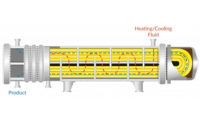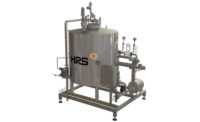Heat exchangers add pizzaz to processing operations
State-of-the art heat transfer technologies are enhancing functionality and making equipment selection increasingly important.

Corrugated tubes can help prevent fouling on heat exchangers. (Photo courtesy of: HRS Heat Exchangers)
Heat exchangers are becoming a more powerful element in the drive by dairy processors to enhance operational efficiencies.
By selecting the optimal exchangers for their specific product lines and technology configurations, operators are in position to increase production and energy savings while upgrading sanitation. Yet, the wide range of equipment options with diverse attributes can make equipment selection tricky.
Processors use exchangers to transfer heat between two or more fluids during the cooling and heating processes without mixing the fluids together, and the devices support a wide range of dairy functions, including pasteurization, sterilization, separation, packaging, formulation, and heat treating and cooling.
“Wherever heat needs to be transferred to or from a fluid, you will probably find a heat exchanger,” says Kevin Anyanwu, proposal and order execution manager for SPX Flow Inc., a Charlotte, N.C.-based heat exchanger manufacturer.
Exchangers also support waste heat recovery in which processors collect heat that would have otherwise dissipated into the air inside or outside a facility and use it in other plant areas that require heat generation, says Tim Tolley, principal of Fond du Lac, Wis.-based Excel Engineering Inc.
Processors, for instance, can use shell and tube exchangers to recover heat from process steam, distillation processes, or refrigeration and air-conditioning systems. Other heat recovery sources include coolants from engines and exhaust streams from furnaces, dryers, and exhaust stacks, Tolley says.
In addition, exchanges can support clean-in-place (CIP) applications that use steam or hot water as a heating media to remove product residues and microorganisms from inside tanks, pipes, vessels, and process equipment without requiring disassembly, he states.
“Heat processing goes hand in hand with dairy processing for quality control and product optimization,” Tolley notes.
Heat exchanger options include plate exchangers that consist of several layers of flat plates that are stacked to create a series of channels for the liquids to flow through; shell and tube exchangers in which shells contain a bundle of tubes with fluid running through and over the tubes to transfer heat between the liquids; and scraped surface exchangers that are designed to keep heat transfer high while keeping the heat transfer surface consistently clean when handling high viscosity fluids and fouling substances.
Be particular in picking systems
When considering heat system option for one’s plant, dairy processors should gauge a technology’s impact on cleanability, thermal efficiency, runtimes, and ease of maintenance, Anyanwu says.
“The consequences of selecting the wrong heat transfer solution range from diminished process efficiency and compromised safety to non-compliance with regulations,” he states.
Analyzing a device’s heating or cooling media, heat sensitivity, and rheological properties before purchasing is vital as well, Tolley says. The types of foods under production – yogurt or cheese – will help determine the optimal models for use in dairy facilities, adds Melissa Fryer, field sales manager for Alfa Laval Inc., a Richmond, Va.-based technology supplier. She recommends that processors compare the benefits and drawbacks of specific equipment when making decisions.
While a plate heat exchanger, for instance, provides the most efficient form of heat transfer, the small gap between the plates and the plate pressure rating limits the amount and size of product particulates and the degree of viscosity that it can support, Fryer notes. Scrapped surface heat exchangers, meanwhile, can better support products with higher viscosity and large particulates but such equipment typically is more expensive, states Jeff Wojtkowski, Alfa Laval business development manager.
Such particulates may include fruit chunks in yogurt, while yogurt itself can have elevated levels of viscosity, says Jordan Cook, business development leader for service at Central States Industrial (CSI), a Springfield, Mo.-based exchanger distributor.
“Processors need to consider the product first and the equipment second when selecting heat exchangers,” he states.
Ultimately, exchanger designs must support what processors value most, and that can vary by circumstances, Anyanwu notes.
“One project may need high heat recovery, which can lead to large regenerators,” he explains. “Others may require a very low-temperature approach, which can have dramatic effects on the size of the exchanger.”
Technical sizing is especially important for the processing of complicated products, such as fluids, which change in consistency when undergoing mechanical stress. This produces either more or less viscous, or fluids, with a high solids concentration, Anyanwu says, noting that such situations may require an exchanger frame that can rapidly open and close to promote easy cleaning and maintenance.
A host of variables to explore

When it comes to an effective design for heat exchangers, dairy processors should share details of their food products with heat exchanger applications engineers, SPX Flow’s Anyanwu says.
This includes hot water flow rates; the glycol concentration necessary for cooling; and the available pressure drop which can alter the efficiency of other equipment in the system, such as pumps, homogenizers, and boilers, he states. Otherwise, “the engineer may have to make an assumption to complete the design,” Anyanwu notes.
Product flow rates and temperature profiles also will dictate the type of technologies that are optimum for each processing plant, says Adam Koss, mechanical engineer at Koss Industrial Inc., a Green Bay, Wis.-based equipment manufacturer. “Once this is known, vendors can select the ideal heat exchanger for the situation, and then the next key element in the system can be chosen, which is the pump to move the product safely through the selected heat exchanger,” he explains.
Additionally, reducing contamination on the exchanger surface makes it much easier for the exchanger to support a product’s viscosity, relays Matt Hale, international sales and marketing director for Marietta, Ga.-based HRS Heat Exchangers.
“A well-designed heat exchanger, such as those which use corrugated tube designs, will be more resistant to fouling, and will, therefore, operate more efficiently for longer without the need for cleaning or other interventions,” he states. Avoiding fouling which can occur when fluids degrade near the tube wall and layers of solids deposit or stick to the wall, or when components in the fluid change to a solid state and deposit on the heat exchanger surface is important, Hale adds.
“The key for producers is to provide as much information as possible, not only about the product and service fluids, but also temperature regimes, required throughput, and production rates so that the correct heat exchanger solution can be designed,” Hale says. “The two most important considerations are the product, and what you are trying to do to it. Pasteurizing liquid milk, for instance, is a much simpler process than cooling curds or yogurt, where maintaining product quality and integrity is essential.”
Take time to avoid trouble

Because most heat exchangers are part of a larger processing system, incorporating technologies with compatible dimensions and weight also is necessary Anyanwu states.
“If an exchanger is not properly sized, heat-sensitive products could be burned or crystalized,” adds Sue Rhyner, sales engineer at Enerquip Thermal Solutions, a Medford, Wis.-based heat exchanger supplier.
Yet, making purchase decisions without possessing the necessary equipment knowledge remains a key processor mistake when incorporating technologies, CSI’s Cook says. He recommends that operators should understand available technology options and how each exchanger relates to their products.
“Not having good data from an owner on their product properties requires significant amount of engineering efforts by heat exchanger manufacturers to determine if their product line fits the bill,” Excel Engineering's Tolley notes.
While cost-comparisons are an essential element in purchase decisions, analyzing pricing can be tricky as systems with a lower initial investment will not necessarily be the most economical long-term solution, Cook says.
“We find fairly often that when upfront cost is the No. 1 purchase driver for a process, there are inevitably costs down the road that may result in a greater total cost of ownership,” he states. Steep maintenance fees, difficulties in obtaining spare parts, and inadequate device support from the supplier, for instance, can contribute to higher overall expenses, Cook adds.
“Make sure you are dealing with a supplier that has a full picture of what’s available and what is best suited for your specific need,” Cook notes. “If you don’t feel like you are getting a good answer to your questions about equipment, keep looking.”
It also is prudent for processors to keep abreast of newer equipment designs so they can incorporate the most effective solutions. Contemporary technologies, for instance, are enabling greater thermal efficiency, “which is the device’s main role,” Anyanwu says. Equipment upgrades also are enabling more production runs between cleaning cycles, he states.
“Dairy producers are demanding heat exchangers that can run cleaner for longer periods and that they can clean easily,” Anyanwu notes. “This influences the sustainability of the operation since the cleaning cycle will often employ chemicals that can be costly and difficult to dispose or recycle. With the increased focus globally on energy costs and sustainability, maximizing heat transfer efficiency is more important than ever.”
Next-generation plate heat exchangers, meanwhile, are offering wider gap plates to increase the spacing between plates and reduce the threat of solids catching in the unit when a product’s fluids contain fibers or coarse particles, Koss says. Nevertheless, Hall notes that more processors are moving from simple plate exchangers to shell and tube designs because of more favorable maintenance costs, operational life cycles, and resistance to fouling.
Anyanwu concludes that an “evolution” in heat transfer technologies is underway, including steam injection technology that can generate rapid temperature changes without the loss of product flavor.
Looking for a reprint of this article?
From high-res PDFs to custom plaques, order your copy today!





